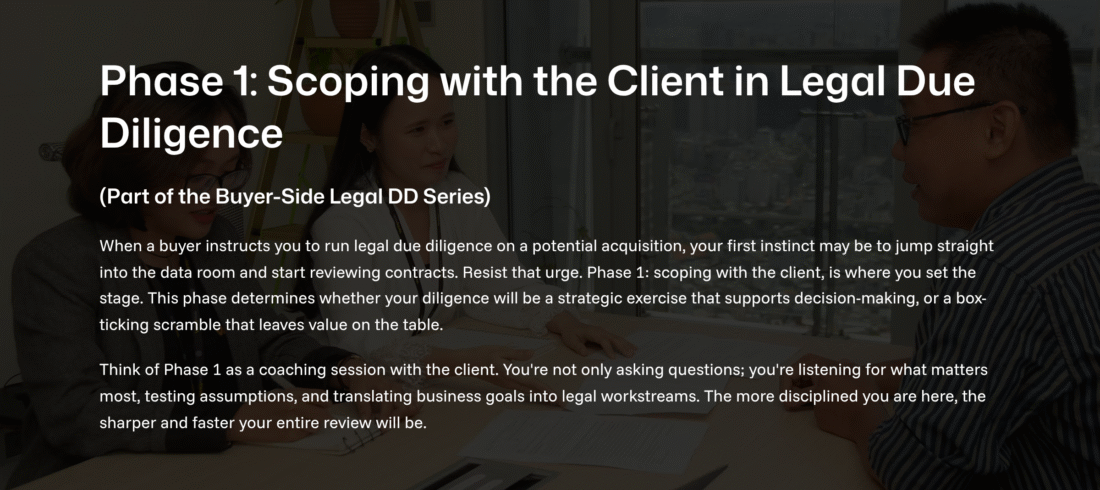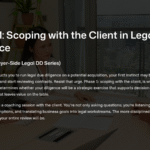To read or download the article, please click the following link.
Introduction: Why Legal Due Diligence is More Than a Checklist
In every M&A transaction, due diligence is often described as “checking the box” before signing. But any lawyer who has lived through a turbulent deal knows that legal due diligence is not about ticking boxes—it is about understanding the risks that can kill a deal, the issues that can shift value, and the levers that can protect the buyer when things go wrong.
This series is written for lawyers, investors, and deal professionals who want more than a surface-level view. It is designed to show how due diligence actually works in practice when acting for a buyer. We will walk through the process step by step—from the moment a deal mandate lands on your desk, through the different phases of diligence, and finally to how those findings shape the purchase agreement, conditions precedent, and post-closing integration.
Unlike academic outlines or high-level guides, these articles aim to be practical, detailed, and coach-like. Each phase will be explained not only in terms of what needs to be done, but also why it matters, what to watch for, and how to respond when red flags appear. You will see where young lawyers often get stuck, how experienced practitioners think about materiality, and why certain industry-specific risks can change the entire trajectory of a deal.
Throughout, the focus will remain practical: what a buyer’s legal team actually needs to deliver, what red flags must be escalated immediately, and how diligence findings connect directly to negotiation outcomes.
In short: this is not just a “how to read documents” manual. It is a roadmap for thinking like a deal lawyer, seeing the big picture while staying disciplined in the details.
Phase 0: Setting the Ground Before Legal Due Diligence Begins
When we think of due diligence in an M&A deal, most young lawyers rush straight into contracts, data rooms, and red flags. But seasoned practitioners know that the most critical work happens before we even open a single file. Phase 0—what I call Internal Readiness—is about creating the foundation for diligence. Skip it, and the process quickly becomes messy, duplicative, or worse, non-compliant with law and ethics. Do it right, and the rest of the journey runs smoothly.
Let’s walk through Phase 0 step by step, not just as a checklist, but as a way of thinking and working.
Start With a Mission Brief
Every deal begins with clarity. Spend the first hour capturing the essentials: Who is buying, who is selling, what’s the deal type (share, asset, merger), and where the companies operate. Then ask the most important question: Why does the buyer want this business? That answer tells you what the “crown jewels” are—IP portfolios, land banks, licenses, or maybe simply customer contracts.
If you can’t explain the deal thesis in two sentences, stop. You don’t yet understand the mission.
Clear the Conflicts Before You Touch Anything
No due diligence begins until we know we’re allowed to act. Conflict checks are more than a formality: they protect the integrity of our work and the client relationship. Be thorough—check not only the target’s current name, but also old names, subsidiaries, holding companies, and even directors.
If there’s overlap—say, our firm once advised the target on a policy we now have to review—we may need ethical walls or, in extreme cases, to decline the work. The output here is simple: a clear “green light” email and, where necessary, a short memo setting out who is inside or outside the wall.
Lock Down Engagement Terms and NDAs
Two documents matter at this stage: the engagement letter with our client and the NDA with the target.
The engagement letter defines our role and scope. It should explicitly cover that we may coordinate local counsel and specialists. The NDA, meanwhile, must be strong enough to let us do our job. Watch for clauses that prevent us from keeping notes, or that restrict our ability to share findings with regulators.
Equally important is to protect our work product: make sure “derivative materials” (our memos, trackers, analyses) are expressly treated as confidential information. Without that, we risk being forced to return or destroy the very insights the client is paying for.
Build the Right Team and Assign Roles
Legal due diligence is not a solo act. From day one, identify the key workstreams: corporate, contracts, IP, employment, real estate, regulatory, privacy, sanctions, environmental, disputes, and so on. Assign clear leaders for each.
As coach, your job is to prevent duplication. Two associates reading the same customer contract is wasted time; one silent workstream is a blind spot. Solve this by publishing a simple RACI chart—who is Responsible, Accountable, Consulted, and Informed. And insist on discipline: one central folder, one live issue tracker, one weekly client call.
Decide What Counts as “Material”
Young lawyers often drown in paper because they don’t know when to stop. Phase 0 is where we set the rules of the game.
Materiality comes in two forms:
- Quantitative thresholds: e.g., contracts above 1% of annual revenue, litigation with exposure above 0.5% of enterprise value.
- Qualitative thresholds: clauses that are always material no matter the size—change-of-control restrictions, exclusivity, most-favored-nation rights, or essential licenses.
If the client faces 200 nearly identical contracts, don’t read them all. Agree on sampling: the top twenty by value, a random handful, and any that contain critical clauses. Put all this into a one-page Materiality Memo and get the client’s sign-off. That memo is your shield when someone later asks, “Why didn’t you read every single lease?”
Plan the Timeline and Deliverables
Deals move fast. A buyer may want signing in a month. If you don’t plan upfront, diligence gets compressed into chaos. Phase 0 is where you map the path:
- Week 1: Issue the first request list, start red-flag review.
- Week 2: Deliver the Red-Flag Memo.
- Week 4: Deliver the full DD report with annexes.
And at every stage, define deliverables: a ten-page Red-Flag Memo, a detailed annexed report, a consent/filing tracker, and an issue register with “deal levers” (price chips, indemnities, CPs). These are not just outputs—they are the expectations that shape how your team works.
Stay Clear of Gun-Jumping: Clean Teams
If the buyer and target are competitors—or even potential competitors—you cannot let competitively sensitive information flow freely. Phase 0 is when you decide whether you need a clean team.
Label information clearly: customer-specific pricing, margins, forward-looking plans—these belong in the clean room. Only lawyers and neutral experts should see them, never the buyer’s commercial managers. Then sanitize the outputs before sharing with the deal team.
The rule is simple: you can plan for integration, but you cannot act as though you already own the company. No telling the target how to price or whom to hire until closing.
Merger Control and Foreign Investment: Triage Early
Don’t wait until the last minute to realize your deal needs antitrust or FDI filings. In Phase 0, map the jurisdictions, estimate revenues by country, and flag overlaps or sensitive sectors. If filings are mandatory, note that they can take months, not weeks.
A preliminary filing map, even if high level, gives the client visibility into timing risk. And it ensures that your red-flag report isn’t blindsided by a regulator.
Tools and Hygiene
Finally, Phase 0 is about discipline. Create the trackers—Issue Register, Q&A Log, Request List, Consent Tracker—before the first document arrives. Make sure everyone knows the naming convention, where to save files, and which version of the report is “live.”
When the data starts flowing, this discipline will be the difference between a coherent red-flag memo and a disorganized scramble.
The Phase 0 Exit Checklist
By the time you close Phase 0, you should have:
- Cleared conflicts and walls, if any.
- Signed engagement letter and NDA.
- Named the team and assigned roles.
- Approved a materiality memo with the client.
- Published the timeline and deliverables.
- Decided on clean team protocols.
- Drafted a merger control/FDI triage note.
- Activated trackers and file hygiene rules.
- Held the kickoff call with a one-page mission brief.
Coaching Note
For junior lawyers, Phase 0 may feel like bureaucracy before the “real work.” In truth, it is the real work. If you take shortcuts here, you’ll pay for them later—with missed red flags, duplication, or even regulatory breaches.
Think of Phase 0 as laying the foundation of a building. Nobody admires the concrete slab, but without it, the tower will collapse.







